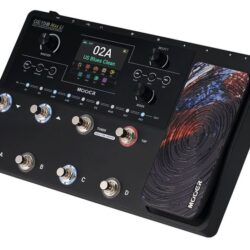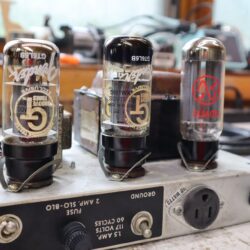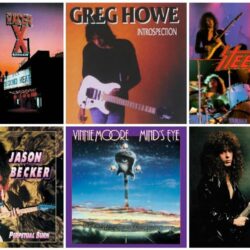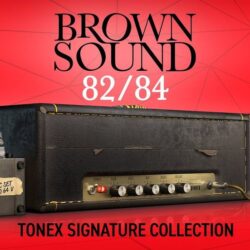
OFFER ENDS SOON! ‘Born Human: The Life and Music of Death’s Chuck Schuldiner’ Death-luxe Edition ALMOST GONE!
There are only 160 copies left of our special edition version of Born Human, the biography of death metal pioneer Chuck Schuldiner! Get it with the T-exclusive shirt now!
The post OFFER ENDS SOON! ‘Born Human: The Life and Music of Death’s Chuck Schuldiner’ Death-luxe Edition ALMOST GONE! appeared first on Decibel Magazine.
Album Premiere: Matt Miller – ‘Fiber Tormentum’
Tech death maestro Matt Miller is dropping his latest album, Fiber Tormentum, via Exitus Stratagem Records on September 12. Here is a day early here!
The post Album Premiere: Matt Miller – ‘Fiber Tormentum’ appeared first on Decibel Magazine.

MOOER Expands Its Multi-Effects Range with the GE150 Max and GE150 Plus
Since its initial release in 2019, MOOER’s critically acclaimed GE150 has seen several significant improvements, including through the GE150 Pro and the more recently announced GE150 Plus. However, the latest addition to the series, the GE150 Max, includes some of the most impactful additions to the series so far, all while staying true to the device’s existing functionality. For existing GE150 users, the first thing they will notice is that, rather than having just two multi-functioning footswitches as with the original, the GE150 Max includes 8. Four of these footswitches are dedicated to switching between the four presets of each bank, whereas a further two are used to switch between banks. This is in contrast to other MOOER multi-effects pedals, where pressing two preset switches would typically shift the banks, with the new system making bank changes more accessible during a performance.The remaining two footswitches are used to activate the tuner function, the 80-second looper system, and to determine the universal tap tempo. Despite these control mechanism changes, the GE150 Max has retained its predecessor’s range of preloaded tones and effects. 50 preset banks are provided, each with 4 presets, totalling 200 customizable slots.Many different models of delay, reverb, and modulation effects can be applied to these slots, but most importantly, the device comes with 55 preamp models, each of which is based on nonlinear modeling technology, helping to produce realistic emulations of classic amplifier tones. However, users are not limited to these tones, as the GE150 Max also supports MOOER’s MNRS amp sampling system, in addition to third-party IR files for cabinet emulations, allowing users to greatly expand the device’s tones through uploading their own. To visualize the tones and effects that are currently loaded, the device is fitted with a 3.5″ LCD color display, providing real-time visual feedback on the effect chain and each module’s parameters. To edit these, the “Select” and “Mode” dials can be used, enabling guitarists to quickly create their own effects chains and then save them. Interestingly, the effect chains also support MOOER’s new CTRL function, which enables users to map single effect modules to footswitches, facilitating more granular real-time control over the chain. As with the original GE150, the Max edition sports an integrated expression pedal that can be mapped to tone and effect parameters, as well as output volume, adding yet another control mechanism for live expression. Interestingly, though, the Max has been augmented by the new “SPILL-OVER” function. Essentially, this ensures that delay and reverb effect tails will fade out naturally when switching presets, making smoother and more natural transitions possible in a live setting.In terms of the internal drum machine and looper, MOOER has stuck to the successful formula of the original GE150. 80 seconds of looping time allow for creative improvisations and loop-based compositions, and a 40-style drum machine is also provided, complete with 10 metronomes. The previously mentioned “Tap” footswitch can be used to accurately determine the BPM of these features in real-time.Aside from the GE150 Max’s internal features, it also boasts an impressive upgrade on its audio output options. Most notably, in addition to the expected 1/4″ stereo outputs, it is also fitted with a stereo balanced XLR output. Guitarists can choose this output option to shield their output from signal degradation and distortion over long-distance cables, guaranteeing a cleaner, more stable, and generally more professional live output than was previously possible.As if this weren’t enough, an Aux In port is also provided for connecting to smartphones or external audio players, allowing guitarists to jam along to their favorite backing tracks or rehearse their band’s material. The device’s USB port can even be used for OTG recording into a mobile device, as well as for the management of presets, sample files, and firmware through a PC. Combining this versatile selection of audio routing options with the GE150 Max’s upgraded functionality, guitarists truly have everything they need for professional-grade live performance, all within a light-weight and compact package.Product Features8 multi-purpose footswitches3.5″ LCD color display200 preset slots across 50 banks of 4 presets55 preamp models, made possible through intelligent nonlinear sample technologyAmplifier and cabinet modules support MNRS sampling filesCabinet simulations support third-party IRsParameter-mappable expression pedalCTRL function, allowing footswitches to be mapped to toggle individual modules within an effect chain presetTap-tempo footswitch“Spill-over” functionality for smooth reverb and delay transitions during preset switchesBuilt-in 80-second stereo looperIntegrated drum machine with 40 drum patterns and 10 metronome modesMono ¼” inputs and outputsXLR balanced output, ideal for the prevention of signal degradation over long-distance live audio routingAux input port for external audio playbackUSB-C port for tone editing, recording, firmware updates, and mobile device connectivity (via OTG)The GE150 Max will be available from the official distributors and retailers worldwide on 10th September 2025.Following the success of the original GE150 pedal, MOOER is excited to introduce the new GE150 Plus, a new multi-effects and amp-modelling pedal. The device has been upgraded to offer guitarists advanced functionality, greater performance flexibility, and enhanced sonic quality through the new GE series design language and user interface.First and foremost, the GE150 Plus provides memory for up to 198 preset patches, giving users a comprehensive range of tonal possibilities for various musical styles. Presets can be crafted through effects such as reverb, modulation, and dynamic enhancements, and most importantly, 55 precise preamp models developed using MOOER’s intelligent nonlinear sample technology. This enables the pedal to accurately reproduce the unique tonal characteristics and dynamic response of classic amplifiers, further enhanced by the device’s amplifier and cabinet modules. Both amps and cabs allow for loading MOOER’s MNRS sampling files, while the cabinet simulations also support third-party impulse response (IR), further expanding the device’s flexibility.Another particularly impressive new feature of the GE150 Plus is the “spill-over” function, which enables delay and reverb effects to fade naturally when switching between presets–a feature that was missing from the original GE150. Ultimately, this ensures smooth, uninterrupted performance when making sonic changes during live performances.As with past editions of the GE150, the pedal includes a convenient and intuitively designed 80-second stereo looper. This can be used in combination with the GE150 Plus’ groove station, which includes 40 integrated drum patterns alongside 10 metronome modes. All of these features are controlled effortlessly through three multi-purpose footswitches, bringing all manner of creative purposes for both live looping and rhythmic practice. An expression pedal is also built into the device, giving guitarists further dynamic control over parameters in their effects chain.Compared to the original GE150, the GE150 Plus has USB connectivity that is significantly enhanced. Through USB-C, the pedal can be easily integrated with MOOER’s PC software for preset editing, as well as for data management, firmware updates, and mobile device audio recording through an OTG cable. An aux input port further expands practice possibilities by enabling external audio sources like smartphones, software, or other hardware to be used as a backing track.Following MOOER’s recent trend of producing fully portable products for musicians on the move, the GE150 Plus is available in two distinct editions, one of which is battery-powered. The standard model offers reliable mains-powered operation, while the GE150 Plus Li version also incorporates an integrated lithium battery, providing approximately 9 hours of continuous use. Additionally, the GE150 Plus Li comes with an exclusive black finish. Overall, the GE150 Plus continues MOOER’s commitment to delivering powerful, versatile, and travel-friendly solutions, making it an essential upgrade within the critically acclaimed GE series.Product FeaturesUp to 198 preset patches55 preamp models, made possible through intelligent nonlinear sample technologyAmplifier and cabinet modules support MNRS sampling filesCabinet simulations support third-party IRsThree multi-purpose footswitchesParameter-mappable expression pedal“Spill-over” functionality for smooth transitions between effect tailsBuilt-in 80-second stereo looperIntegrated drum machine with 40 drum patterns and 10 metronome modesUSB-C port for tone editing, recording, firmware updates, and mobile device connectivity (via OTG)Aux input port for external audio playbackCompact, lightweight, and travel-friendly designAvailable in standard (white) and lithium battery-powered Li version (black)
Read more »
Oh, No! My Amp Is Making Noise!
If you’ve owned a tube amp for pretty much any amount of time, you’ve been there: Your amp starts making noise—probably at the worst possible moment, whether onstage, in the studio, at rehearsal, or when you just really want to play—and you don’t know what to do. Maybe you keep it cool, but maybe you panic: Is my amp broken for good? Is this going to cost me hundreds of dollars? Fortunately, there are a few basic things you can check before you call your amp tech in a frenzy. Ultimately, an all-tube guitar amp is actually a very durable device. But it’s important to remember that these amps need maintenance and have parts that are going to need to be replaced over the course of their lives—and tubes are the most likely place to check when you’re having a problem.Many vacuum tubes are “military grade,” which means they can withstand shock, vibration, humidity, temperature, and many other harsh conditions. That doesn’t mean they are fail-proof, though. So, when your amp is making noise, here are some ways to check out your tubes. LookDo a visual inspection. Are your amp’s tubes bright and shiny, or do they look weathered and dirty? If they look old, they may be old. This doesn’t have to be a sign of something wrong, but tubes wear out like lightbulbs—they work until they don’t. I usually say power tubes have a two- to five-year lifespan (for professionals, it’s more like six months to two years). Preamp tubes have more like a five- to 20-year life. They can function longer but start to get problematic before they just die.Look at what’s going on inside. Is the clear part of the glass still clear? If there is a smoky look on the inside of the glass, that is a sign of heavy wear. Look at the shiny mirror-looking part; that is the getter flashing. It should look bright, though sometimes there is a little fuzziness along the edges. If it is getting smoky, then the tube is tired. And if it has gone completely white, the tube is toast. The last visual is best done in darkness. Look for the heater element inside. It is a wire in the very center of the tube structure that glows red when operating. Don’t worry about what shape it is, how much you can see it, or if it looks exactly like the other tubes. If it is glowing, it’s good; if it is dark in there, it’s toast.ListenLet’s move on to audible diagnostics. The amp works but is making extraneous noises. The first thing to do is unplug the guitar cable from the input of the amp, so nothing is plugged in, the amp is fully on, and the tone controls, volume, and master (if applicable) are full on. What noises do you hear? If it is silent with a tiny little bit of background noise, that is as good as a guitar amp gets.
Are you hearing an electronic, almost morse-code sound? A common modern problem is RF (radio frequency) noise from routers, cell phones, and transmission towers. It is not the amp and there is nothing to fix, but if you try moving the amp around the room or building, you may find a quieter place.
Is the amp making a constant “shhhhh” sound? Does it get louder if you turn the volume knob up? That is thermionic emission, the noise of electrons flowing. It is a byproduct of gain. Low-gain amps have less, and high-gain amps suffer greatly. Some tubes can add to this, so if you replace the first couple tubes in the signal path and it helps drop the noise floor, then keep the noisy ones for less critical positions.
Is the amp sitting there doing the snap-crackle-and-pop thing? This can be a tube issue, but most of the time it is a component issue inside. If you have a known good tube, you can replace the tubes one at a time, seeing if the noise changes. If you find that it was a tube, that tube is toast, so don’t use it as a spare.
Now, let’s talk about microphonics. Because of the amount of gain we have in guitar amps, microphonic tubes can be problematic. Start turning the amp volume/gain all the way up. If you get a howl, like with an open microphone, you have a microphonic tube. If it is still behaving but you can tap on the amp and get a sound like tapping on a microphone, that can be acceptable. Finding the CauseThere are multiple tubes in an amp, so let’s find the root of the noise. The first thing is tap testing. The best tool is a pencil with an eraser. One by one, tap on the tubes with the amp on and turned up. If you get a significant microphonic sound from one, it should be swapped out with a quieter one. Now, this is the thing: A little bit of microphonics is normal, so it will take a little getting to know your amp to learn what is acceptable or not. Certain brands/models of tubes are better than others, so just because it’s new doesn’t mean it’s better or even good. As you go down the line of the signal chain, the gain is less, so you are looking for slight noises. Once you get to the power tubes, they can be microphonic, but they don’t howl like a preamp tube. They make a thud sound when tapped.The other thing we’re looking for with this tap testing is rattling. Again, there is a certain level of acceptable rattle. But if you can hear it through the speaker, that’s unacceptable. If you have power tubes that rattle, this sometimes does not come through the speaker, but you can hear it when playing the amp at lower levels. If that bothers you, then they need to be replaced even though they’re functioning properly.The last diagnostic is pulling the preamp tubes (not the power or rectifier tubes). Starting with the first tubes in the signal chain, pull them out one at a time and listen to see if the noise goes away. If you pull a tube and the noise disappears, then either that tube is the culprit, or your problem lies in that part of the circuit.If you’re looking for a quick fix to get you through your gig or session and you narrow your problem down to a tube, go ahead and swap it out. If your amp is fixed bias, you may still need to head to your tech tomorrow and have it biased, but you’ll get your work done today. And when in doubt, replace your old tubes. If it turns out that wasn’t the issue, you now have good spares for when a tube does eventually give you problems.
Q&A and Full Album Stream: Dazzling Killmen Reissue Debut ‘Dig Out The Switch’
Hear the remastered version of Dazzling Killmen’s Dig Out The Switch! And read our conversation with guitarist and vocalist Nick Sakes and drummer Blake Fleming about making the album, reuniting, surviving cardiac arrest, and more.
The post Q&A and Full Album Stream: Dazzling Killmen Reissue Debut ‘Dig Out The Switch’ appeared first on Decibel Magazine.

A Guide to Shrapnel Shred
Chops: AdvancedTheory: IntermediateLesson Overview:• Work through sweep arpeggios in the style of Jason Becker.• Add more chromatic notes to your improvised solos.• Make your riffs more compelling with unexpected rhythmic subdivisions.Click here to download a printable PDF of this lesson’s notation. Shrapnel Records introduced the world to some of the most virtuosic rock and metal guitarists to have ever plugged into a high-gain amp. Starting in the ’80s, an era that has subsequently become infamous for guitar gods, Shrapnel’s founder Mike Varney carefully selected the cream-of-the-crop players for his unique record label.Some Shrapnel alumni are best known for sweep picking, others for insane alternate picking, and yet others for emphasizing legato fretwork. But all of them are known for playing a lot of notes in a very musical way. What made many of these players great, in my opinion, is that each took a unique approach to playing and writing within the fairly specific “shred” genre. Want to acquire some tricks of their trade? Let’s take a look at key ideas and techniques used by several of Shrapnel’s heaviest hitters.Most people associate Shrapnel guitarists with technical lead playing, but before we go there let’s first visit the often-overlooked art of playing rhythm. In my opinion, Paul Gilbert and Bruce Bouillet of Racer X were absolute masters of creating rhythmically exciting and unexpected metal riffs. These were often based on strong rhythmic hooks that included subdivisions and interwoven exchanges, and took surprising aural twists and turns.Ex. 1 is a Racer X-style riff in A minor that illustrates the basic idea of taking one rhythmic pattern and throwing in surprise subdivisions. This riff’s main rhythmic pattern is based on three-note groupings of 16th-notes. In the first measure we encounter a new subdivision on beat 4. Hear how those 32nd-notes surprise the ear? It’s a great example of what Racer X was known for. Another example of this effect is in the riff’s second fill. We have a 16th-note triplet run to wrap up the first repetition (starting on the “and” of beat 3 in measure 2), and again, the change in subdivision from the main 16th-note pattern creates an additional rhythmic twist.Click here for Ex. 1Now that we’ve had a dose of rhythmic content, let’s shift over to the kind of lead playing that makes many listeners’ jaws drop. Because he introduced pop and R&B-inspired chord changes and funky rhythms to what was fundamentally a hard rock and metal label, Greg Howe is arguably one of the most distinctive Shrapnel artists. To make things even more interesting, he favored an innovative tapping technique and infused his playing with chromatics.Inspired by the record Introspection, Ex. 2 is a Greg Howe-style lick over a series of dominant 7 chords. Hear how the chromatics are interwoven between E7 and B7 chord tones on the weak parts of the beat? This is a common jazz guitar technique, but it’s made very Howe-ish thanks to Greg’s grooves, feel, and note choices. Next over A7 comes one of Greg’s most famous tapping techniques. This line also demonstrates his “hammer-on from nowhere” technique, which means that the hammer-on note isn’t approached by a previously picked note. Finally, we have another of Greg’s famous tapping techniques over the F#7. Here, we take three-note-per-string scales and instead of picking every note or playing full-on legato, use a hammer-hammer-tap pattern to cover the ascending phrase.Click here for Ex. 2Another Shrapnel powerhouse is Tony MacAlpine, who is famously known for his blazing picking and his blend of classically inspired themes and contemporary instrumental music. Ex. 3 pays tribute to his approach to arpeggios.The opening phrase is one of my favorite Tony-isms. We’re creating a major 7 arpeggio, in this case Dmaj7, by only using the lowest two strings. Keep in mind that there’s absolutely no picking here—it’s strictly legato and tapping. But the real interesting thing about this kind of line is the context in which Tony often uses it. Here, we’re in a Bm tonality, so we can use a D major arpeggio (Bm’s relative major) and still stay in the key.Click here for Ex. 3We’ve explored a variety of tapping and arpeggio ideas, but haven’t yet encountered one of the most common staples of the Shrapnel guys: alternate picking licks! Many of the Shrapnel guitarists are well known for playing long, scalar runs in which they pick each note. If used wisely, this can be one of the simplest ways to enhance your playing, as these runs are mostly pattern-based and primarily built on the three-note-per-string scale fingerings. A simple alternate-picked line in B minor, Ex. 4 starts with a six-note scale shape that’s copied across three octaves. You’ll find this fragment (the first three beats of the first measure) on many Shrapnel albums. Keep in mind that strict alternate picking is crucial for the accuracy and cleanliness of a lick like this, so be sure to practice it slowly.Because these lines work so well in the three-note-per-string fingerings, they’re often conducive to some sort of triplet subdivision. The kicker with such licks is that they’re very pattern-based and can end up sounding too much like an exercise. Use them wisely and musically. Click here for Ex. 4And last but not least, what would a column on Shrapnel be without a mention of the legendary Jason Becker? For dedicated shredders, his playing and spirit need no introduction, but if you need one, check out this trailer for the excellent documentary Not Dead Yet. Ex. 5 is a workout in Becker-style sweep arpeggios. One point that was unique about Jason’s particular approach to sweep picking is that he extended certain arpeggio shapes further than other players did. In this example, all of the shapes extend down to include two notes on the 5th string. It’s fairly rare to see the Bm and E shapes extend down that far, but that’s part of Jason’s nuanced magic. The key to successfully playing sweep arpeggios lies in the picking pattern. It’s always a specific, non open-ended pattern that isn’t as simple as just constant downstrokes and upstrokes. A hammer-on or pull-off is included every time there’s two notes played on the same string. Click here for Ex. 5Keep in mind that playing anything cleanly and accurately lies in practicing very slowly, in time with a metronome. These guys were all masters of fast playing, but I believe they were standouts because they used their chops in clever and musical ways, and that composition was their first priority. So when you’re sitting down with your metronome to blaze through these licks, just remember that music comes ahead of technique.Racer XThis blazing live performance of Racer X’s “Scarified” from 1988 illustrates how Paul Gilbert and Bruce Bouillet varied the rhythms within their warp-speed riffs.Greg HoweGreg Howe improvises an incredible solo over his tune “Come and Get It.” Check out 0:45-0:48 for a great example of one of his signature tapping techniques.Tony MacAlpineHere’s Tony MacAlpine playing “Pyrokinesis” with an excellent view of his fretboard. Marco Minnemann plays the drums on this track and MacAlpine plays everything else. Look for his tapped arpeggios sequences and notice how he weaves them into both the melody and the solo.Jason BeckerThe legendary Jason Becker performs a dazzling mix of feisty, extended-range arpeggios in this clip from a guitar clinic in 1989.
Read more »
Kiesel Unveils Kyber Headless and Masvidalien MIII Models
Kiesel Guitars has introduced the two newest models in the company’s iconic line of custom-built instruments: the Kyber Headless and Masvidalien MIII now join the lineup of Kiesel’s premium US-made instruments.Designed to excel in a variety of musical styles, the versatile Kyber Headless is available in 6, 7, and 8-string configurations, standard or multiscale. Key features include: 7 different body woods for customization25.5” scale length, 15 different fretboard woods for customization, 24 fretsOver 100 different pickup configurationsKiesel-Designed locking nut, headpiece for hanging, optional body scoopsThe Masvidalien MIII is the debut Kiesel signature model from Paul Masvidal, guitarist and composer known for his work with Cynic, Death, Æon Spoke, and Mythical Human Vessel.Built in Kiesel’s California factory, the MIII was designed with strength, resonance, and playability at its core. Inspired by Kiesel’s Kyber model, which Masvidal was already connected to, the MIII began as a natural extension of that instrument but quickly evolved into something uniquely its own, a hybrid guitar that expands on the Kyber’s spirit and opens new creative ground.Key features include:Woods: 5A Poplar top with a Swamp Ash body, Buckeye top with a Roasted Swamp Ash body25.5”-26.5”, Fretboard woods: Ebony, Richlite Diamond, Roasted Maple, Royal Ebony, and Roasted Birdseye Maple, 24 FretThe brand-new Focus pickup, a humbucker made from two blade-style single coils that offers tighter and more precise tonesThe Hybrid carbon fiber/wood neck, the Barbury Castle Crop Circle inlay, Headpiece for hanging,Like other Kiesel models, the new Kyber Headless and Masvidalien MIII are available in a wide range of options for unique customization. Players can select their favorite finish, tonewoods, electronics and hardware to create the guitar of their dreams…expertly crafted in Kiesel’s Southern California custom shop.Kiesel’s new Kyber Headless is available for street pricing starting at $1,599. The new Masvidalien MIII is available for street pricing starting at $3,199. For more information visit kieselguitars.com.
Read more »
Full Album Stream: Nicolas Cage Fighter –I Watched You Burn
Hear Aussie deathcore quartet Nicolas Cage Fighter turn up the heat on I Watched You Burn.
The post Full Album Stream: Nicolas Cage Fighter –I Watched You Burn appeared first on Decibel Magazine.

Steve Morse Band Announces Brand-New Studio Album
The Steve Morse Band has announced details of their brand-new album, Triangulation, which will be released on November 14 via Music Theories Recordings (Yngwie Malmsteen, Ayreon, Paul Gilbert, Vandenberg). To celebrate, they have unveiled the official video for their new track, “Break Through.”“Break Through” is the first new music since the release of 2009’s Out Standing In Their Field. Talking about the track, Steve Morse shares, “This may start with a guitar riff, but the bass carries the melody. It’s just a great feel to play over, and a positive vibe to start the album.”Whenever we think of the greatest guitar players of all time, Steve Morse is a name that’s always in the conversation. This album sees Morse teaming up once again with Dixie Dregs, Steve Morse Band, and Flying Colors bassist Dave LaRue, with Van Romaine [Steve Morse Band/Enrique Iglesias] joining on drums.Steve beams, “Dave and Van have been the bedrock of this trio, and this recording shows why. These guys are unique and incredible musicians on their own, and together, our chemistry is magical. While making the album, we played together, working through parts, riffing off each other, and collaborating on arrangements. I’d bring an idea, and hear it instantly — and then hear it improved. We made this album together, and you can hear it.”There are also some stellar guest features, from Eric Johnson’s majestic contributions to “TexUS” and John Petrucci bringing his inimitable progressive metal thunder and, of course, Kevin Morse joining his father on “Taken by an Angel.”.Executive producer Bill Evans noted, “The compositions are among Steve’s best. And audiences can finally hear every detail of Van and Dave’s performance…the band’s collaborative musicality.” Steve added, “Brian captured me brilliantly, and Carl Roa created more sonic and performance clarity than we’ve ever had.”Morse started his career in the mid-1970s, playing mind-melting jazz-rock with The Dixie Dregs, which earned him multiple Grammy nominations in the process. The following decade, he formed the Steve Morse Band, grabbing an additional Grammy nod, and joined arena heavyweights Kansas, before being recruited by rock and roll originals Deep Purple in 1994. And despite being in one of the world’s biggest bands, he continued to innovate in other projects like Living Loud, Angelfire, and Flying Colors – as well as guitar supergroup G3 – showing the world just how much versatility there was in those magic fingers. He announced his departure from Deep Purple in 2022, choosing to care for his wife, who passed away in 2024, by that point having become their longest-serving guitarist.Naturally, the last few years have been the most personally traumatic of his life, which is perhaps why this year’s creative comeback with the new Steve Morse Band album Triangulation embodies the spirit of a master returning to do what he does best. Its nine tracks are a thrilling ride through the mind of a musician who seemingly knows no bounds, crossing over into a cornucopia of sounds and styles from funk and blues to classical and metal.“The album title Triangulation comes from the concept of aviators, navigators, and sailors looking at two points to pinpoint their exact location at a specific moment in time,” says Steve. It’s a geographical concept that also applies to human life on a broader level, and given the journey Morse has been on in recent years, it’s only natural that he’s been on a path of self-discovery and reflection.Perhaps the most poignant of the nine tracks is “Taken By An Angel” – a tribute to Steve’s beloved wife Janine. Steve left the music world behind to care for her, remaining by her side until her final days. “That song is new territory for me,” explains Morse. “It was put together for my late wife’s memorial service, with my son Kevin playing along. It brought tears to many folks’ eyes because Janine was a huge part of my life and career. People knew her from the Steve Morse Band tours. She was the smiling face opening CDs for me to sign, selling t-shirts, listening to people’s stories in the crowd, and taking photos for VIP visits.”After all the heartache and anguish of the last few years, you can’t help but feel grateful Morse is once again ready to share his creative genius with the world around him. Given his stature among the guitar community – often lauded as ‘your hero’s hero’ in the same way people spoke about Jeff Beck – his creative return marks a new phase of inspiration and brilliance. In that sense, you can tell the release of this record means a lot to him.The band hits the road in October bringing the new repertoire to the stage. Steve Morse shares, “Every generation or so, we put out a new album, and the time is now! We’ll be doing new material on stage, and have enlisted a special guest, Angel Vivaldi, to allow us to better perform some of the layered tunes in concert. Excited to have a bigger sound and new material! See you on tour!” Van Romaine offers, “I am so thrilled for this brand new major Steve Morse Band chapter with new tour dates and an album that was so much fun to record with Steve and Dave LaRue, and a couple special guests. While music is always subjective this Triangulation album is such a gem to me on many levels.”Upcoming Appearances are:10/09 Louisville, KY Headliner’s10/10 Nashville, TN CMA Theater10/12 Charleston, SC Charleston Music Hall10/13 Atlanta, GA Variety Playhouse10/14 Charlotte, NC The Neighborhood Theatre10/15 Raleigh, NC The Rialto Theatre10/16 Annapolis, MD Rams Head On Stage10/18 Elkton, MD Elkton Music Hall10/19 Lititz, PA Mickey’s Black Box10/20 Red Bank, NJ The Vogel10/21 Sellersville, PA Sellersville Theater10/23 Somerville, MA Somerville Theatre10/25 Cohoes, NY Cohoes Music Hall10/26 Ridgefield, CT Ridgefield Playhouse
Read more »
IK Releases Brown Sound 82/84
IK Multimedia releases the Brown Sound 82/84 Signature Collection for TONEX, the third and final installment of the limited TONEX Brown Sound series. This collection features 83 carefully crafted Tone Models, including several amp-only captures for use with your favorite IRs or running through a real cab on stage.As the push for radio-ready hits grew stronger, the Brown Sound became tighter, more refined, and more polished without losing its iconic edge. Users will discover both authentic recreations and thoughtful variations to reflect different theories about how these legendary tracks were recorded.1982 Tone ModelsThe ’82 sessions introduced a brighter, more layered tone while preserving the core character of the previous recordings. The G12-65 speaker remained key to the sound, delivering a tight low end, warm midrange, and a smoother, less spiky high end than the earlier Greenbacks. Recorded in Amigo studios, changes in mic placement and outboard gear added polish and dimension, resulting in a more refined studio sound.1984 Tone ModelsThe ’84 sessions marked a leap forward in tonal precision and production quality. Tracked and mixed at a newly built studio in Coldwater Canyon, the sound became more controlled and processed, yet still retained the grit and energy of earlier recordings. The suspected use of Telefunken EL34s likely contributed to the added warmth and mid-forward presence, while amp tweaks and precise Variac adjustments gave each track its own tonal identity.The Amp: “The ONE”At the heart of the Brown Sound 82/84 collection is “The ONE” – a meticulously crafted Marshall-style amp built from the ground up with the exact same spec as the infamous 1968 Super Lead serial number #12301, including crucial mods that capture the DNA of the early brown sound like no other amp model.No Tone UnturnedEach Tone Model was built using controllable levers like Variac voltage, cab voicing, mic geometry, and parallel load, with options spanning different voltages, speakers, and pickups to reflect the shift from ’82 to ’84. All models are level-matched, offered with or without parallel load, and captured raw without post-processing for authentic, period-correct amp tones.Ready to PlayAs with all collections in the series, these Tone Models were crafted using period-correct gear and capture techniques to recreate the final two albums of that era genuinely. Each Tone Model reproduces the recorded album tone in exquisite detail, offering an ideal foundation for adding time-based effects—either within TONEX or through a favorite pedal.Pricing and AvailabilityThe Brown Sound 82/84 Signature Collection is now available via ToneNET and within any version of TONEX for Mac/PC at $/€99.99.*TONEX Brown Sound 78/79 – $/€99.99* – Includes 50 Tone Models.TONEX Brown Sound 80/81 – $/€99.99 – Includes 73 Tone Models.TONEX Brown Sound 82/84 – $/€99.99 – Includes 83 Tone Models.TONEX ONE Brown Sound Limited Edition – $/€249.99 – Available in white, red, or yellow. Includes Brown Sound 78/79 and a choice of one other Brown Sound collection (a $/€199.98 software value). Existing Brown Sound 78/79 users will receive a $/€50 discount at the IK store.TONEX Brown Sound Anthology Collector’s Limited Edition – $/€599.99 – Shipping now. Box set includes all three colors of TONEX ONE (white, red, and yellow) plus all three Brown Sound Signature Collections (78/79, 80/81, and 82/84). Limited to 200 units worldwide.*Pricing excluding taxes.For complete details and information about the Brown Sound Anthology collections and pedals, and to hear the tones, visit:www.ikmultimedia.com/tonex-brown-sound
Read more »